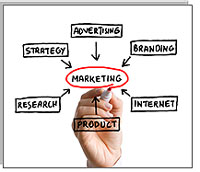Back to Page 1: Sales and Marketing Plans – What Works?
Back to Page 7: How to Manage Each Individual Salesperson – Covered in Your Sales and Marketing Plans
=================================================================
Page 8
The personal effectiveness of your salespeople (and yourself if you do selling) is essential to achieving your goals. After all, the perfect plan implemented badly or not implemented at all, will kill your results.
That’s why the personal management of your reps is such an essential part of your sales and marketing plans.
Introducing the Marketing Checklist as Part of Your Sales and Marketing Plans
Personal management also includes monitoring and updating of each salesperson’s skills.
These include product skills (so your reps understand what is being sold, including any innovations and changes that have been added), and selling skills (understanding how to communicate effectively, demonstrate instructively, persuade convincingly and close definitively).
Your sales and marketing plans should indicate that your technical people will periodically review with the reps what is being offered, to keep them abreast of advancements and of features that may not be fully understood or appreciated.
Also, newly hired technical people could be oriented to the products and services you sell by your sales reps, thus providing an opportunity for cross-fertilization while reinforcing the features most important to your business.
Sales and marketing plans we developed and implemented for a paint manufacturer delivered dramatic results using this strategy. By simply established training workshops for retail stores who sold our paint, we were able to cause revenues to skyrocket, especially for higher margin offerings.
Of course, beyond product skills, remember to develop selling skills as well.
This includes:
- How to listen more effectively,
- Presentation and demonstration techniques that boost participation,
- Watching and understanding body language,
- How to uncover and answer stalls and objections, and
- How to ask for the order.
One of the best training tools for these types of skills is Role Playing, and this should be outlined in your sales and marketing plans.
Role playing and formal training can dramatically improve the results of people who sell for you.
And don’t be afraid to throw curves at them, like surprise objections, as this prepares them to better think on their feet while ensuring they reflexively follow the selling process you have defined.
Marketing Management – The Third Leg of Your Sales and Marketing Plans
Once you have the selling process and your salespeople managed effectively, the third leg for effective sales and marketing plans is coordinating The Marketing Process so it supports or supplements the entire selling process.
To do this, The Marketing Process needs to address three specific elements:
- Providing leads to salespeople,
- Assisting salespeople with the selling process, and
- Direct selling.
Here’s a brief overview of how this all fits together.
PROVIDING LEADS FOR SALESPEOPLE
This is an essential part of your sales and marketing plans.
When your marketing can provide your salespeople with leads to interested qualified prospects, this can be a powerful engine for the growth of your revenues and the success of your business.
Leads can be generated from numerous sources, including:
- TELEMARKETING – In-house or outsourced,
- DIRECT MAIL that drives prospects to request further information (it’s surprising how many sales and marketing plans do not provide for lead generation through this powerful medium),
- MEDIA – Television, radio, print and newspaper advertising (particularly inspiring or directing people to contact you, such as going to a website, using a coupon, entering a contest, etc),
- INTERNET advertising (including pay-per-click and banner advertising, email marketing, joint venture and co-marketing, etc.) that inspires or directs potential customers to contact you (a crucial part of the sales and marketing plans for many businesses),
- PUBLIC presentations such as speeches, conferences, webinars and teleseminars that introduce potential customers to your products or services,
- NETWORKING through trade associations, networking groups, chambers of commerce and community organizations, etc.,
- INFOMERCIALS and WEB-BASED sales presentations,
- WEBSITE SIGN-UP forms (capturing contact information of potential customers),
- WHITE PAPERS (creating interest and awareness of your products and services by prospects – often offering the free White Paper in exchange for the contact information of a potential customer. This can be strategically important to many sales and marketing plans),
- PUBLICITY such as press releases published in magazines, newspapers, web-zines, on television and radio, etc.,
- TRADE SHOWS,
- RETAIL LOCATIONS, particularly when they are clustered to attract buyers as with food courts, shopping centers, industrial parks, geographical hubs (like Silicon Valley), etc.
- REFERRALand tell-a-friend marketing,
- OUTDOOR advertising,
- COUPON packs,
- PROMOTIONAL events,
- …and related sources.
The main feature of each of these methods is, they contain a means for some type of follow-up by a salesperson, through having the prospect provide their contact information or even better, by having the prospect actually request that a salesperson contact them.
==================================================================
See Page 9: The Sales Process, Direct Selling and Beware You Don’t Alienate Distributors as Part of Your Sales and Marketing Plans

